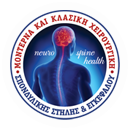
What is Hydrocephalus?
The term hydrocephalus defines the abnormal accumulation of cerebrospinal fluid (CSF) within the normal brain cavities and, as a result, the pressure within is increased. Normally, CSF surrounds the brain and the bone marrow while it supports and protects them. CSF is produced and drained on a regular rhythm (about 0.35 ml/min, so 500 ml/day) in order for its total quantity to remain stable (about 150 ml) as well as its pressure (about 10–15 cm Hg).
What are the hydrocephalus symptoms?
Typical symptoms are:
• Morning headache accompanied by nausea and vomiting
• Drowsiness
• Retinal papilledema
• Hypertension and bradycardia (Cushing reflex)
• Diplopia (due to paresis in the sixth cranial nerve, that is abducens nerve)
• Looking up disorder
Which are the mechanisms that can lead to hydrocephalus?
Mechanisms that can lead to hydrocephalus are:
• Obstruction of CSF circulation due to any reason
• Malabsorption of CSF
• Increased production of CSF
Which types of hydrocephalus are there?
• Obstructive hydrocephalus (chronic, acute)
• Communicating hydrocephalus (nonobstructive)
• Normal pressure hydrocephalus (NPH)
• Pediatric hydrocephalus
What is the cause of the obstructive hydrocephalus?
The obstructive hydrocephalus occurs when the flow of CSF is blocked along one or more of the narrow passages connecting the ventricles. These blocks (obstacles) can be congenital or acquired and may be caused by benign (stenosis of aqueduct of Sylvius, intracranial hematoma, intraventricular hemorrhage) or malignant brain disorders (metastatic or primary tumors).
How is the obstructive hydrocephalus treated?
Surgical treatment is required for the obstructive hydrocephalus. When the block can be unblocked in order for the CSF to flow normally, then this block is removed (e.g., the tumor or the hematoma) and therefore the circulation of the CSF returns to normal and the hydrocephalus is recovered. However, many times this is not possible. In these cases, the insertion of a ventriculoperitoneal CSF drainage valve is inserted. With this technique, we achieve the decrease of the CSF amount within the ventricles of the brain, the decrease of the CSF pressure, and ultimately the decrease of dilatation of the brain ventricles and thus the improvement of the symptoms. When the block that causes the hydrocephalus is located after the third ventricle of the brain, then the treatment technique that is followed is called third ventriculostomy. When applying ventriculostomy, we bypass the block without inserting foreign bodies, such as valves. This method is done endoscopically with laparoscopic assistance through a small trephination.
What is the communicating hydrocephalus and how is it treated?
In contradiction to the obstructive hydrocephalus, the communicating hydrocephalus is not caused by a normal flow of the CSF block but by a malabsorption of the CSF. Initially, we administer acetazolamide but then the insertion of a ventriculoperitoneal or lumbar-peritoneal valve is required.
What is the normal pressure hydrocephalus and how is this treated?
Hydrocephalus developing in a vulnerable brain, such as the elderly’s, can cause dilatation of the brain ventricles but not an increase in the intraventricular pressure of the CSF. The main symptoms of this type of hydrocephalus are three. Specifically, walking disorder, memory and other cognitive functions disorder (a form of dementia), and urine control disorder (incontinence). The aforementioned symptoms caused by hydrocephalus are generally not the same with this type of hydrocephalus.
This syndrome can appear after a head injury or a Central Nervous System infection and the clinical picture is similar to that of ischemic leukoencephalopathy (multiple small ischemic episodes in the elderly’s brain) and of the presenile dementia (Alzheimer’s disease). The definite treatment of the syndrome is the insertion of a hydrocephalus low-pressure valve, either of ventriculoperitoneal or lumbar-peritoneal type. As days go by, the improvement of the symptoms is impressive. In this case, the recovery is easily achieved but the right diagnosis is difficult because the use of invasive and relatively painful methods is usually required, such as the removal of CSF by sternal puncture, or the insertion of an external lumbar CSF shunting for a day or two with the objective of the gradual removal of the CSF and the monitoring of the patient’s changing clinical picture.
How common is hydrocephalus among children?
Pediatric hydrocephalus is quite common and it is estimated that 3–4 babies per 1,000 births will have it. Simple congenital hydrocephalus with no other congenital anomalies accompanying it is estimated at 1–1.5/1,000 births while when it is accompanied by spina bifida and/or meningomyelocele, it is estimated at 1.5–2.9/1,000 births.






